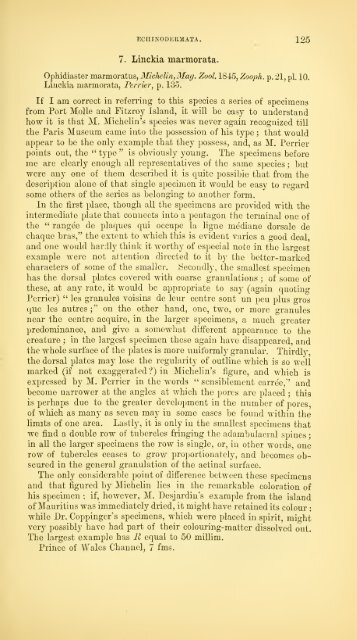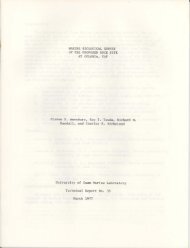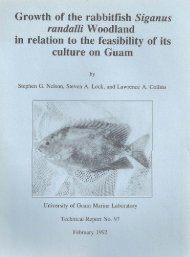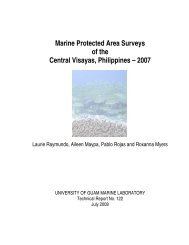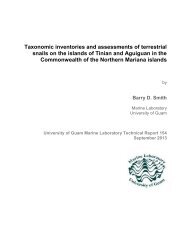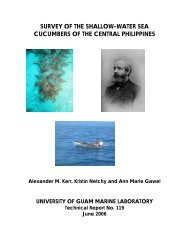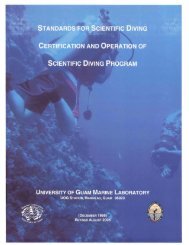Create successful ePaper yourself
Turn your PDF publications into a flip-book with our unique Google optimized e-Paper software.
ECHINODERMATA, 125<br />
7. LincMa marmorata.<br />
Ophidiaster marmoratus, Michelin,Mag. Zuol. 1845, Zooph. p. 21, pi. 10.<br />
Liuckia marmorata, Perrier, p. 13o.<br />
If I am correct in referring to this species a series of specimens<br />
from Port Molle and Fitzroy Island, it will be easy to understand<br />
how it is that M. Michelin's species was never again recognized till<br />
the Paris Museum came into the possession of his type ;<br />
that would<br />
appear to be the only example that they possess, and, as M. Perrier<br />
points out, the " typo " is obviously young. The specimens before<br />
me are clearly enough all representatives of the same species ; but<br />
were any one of them described it is quite possible that from the<br />
description alone of that single specimen it would be easy to regard<br />
some others of the series as belonging to another form.<br />
In the first place, though all the specimens are provided with the<br />
intermediate plate that connects into a pentagon the terminal one of<br />
the " ranges de plaques qui occupe la ligne mediane dorsale de<br />
chaque bras," the extent to which this is evident varies a good deal,<br />
and one would hardly think it worthy of especial note in the largest<br />
example were not attention directed to it by the better-marked<br />
characters of some of the smaller. Secondly, the smallest specimen<br />
has the dorsal plates covered with coarse granulations ; of some of<br />
these, at any rate, it would be appropriate to say (again quoting<br />
Perrier) " les granules voisins de leur centre sent un peu plus gros<br />
que les autres;" on the other hand, one, two, or more granules<br />
near the centre acquire, in the larger specimens, a much greater<br />
predominance, and give a somewhat different appearance to the<br />
creature ; in the largest specimen these again have disappeared, and<br />
the whole surface of the plates is more uniformly granular. Thirdly,<br />
the dorsal plates may lose the regularity of outline which is so well<br />
marked (if not exaggerated ?) in Michelin's figure, and which is<br />
expressed by M. Perrier in the words " sensiblement carree," and<br />
become narrower at the angles at which the pores are placed ; this<br />
is perhaps due to the greater development in the number of pores,<br />
of which as many as seven may in some cases be found within the<br />
limits of one area. Lastly, it is only in the smallest specimens that<br />
we find a double row of tubercles fringing the adambulacral spines ;<br />
in aU the larger specimens the row is single, or, in other words, one<br />
row of tubercles ceases to grow proportionately, and becomes obscured<br />
in the general granulation of the actinal surface.<br />
The only considerable point of difference between these specimens<br />
and that figured by Michelin lies in the remarkable coloration of<br />
his specimen ; if, however, M. Desjardin's example from the island<br />
of Mauritius was immediately dried, it might have retained its colour :<br />
while Dr. Coppinger's specimens, which were placed in spirit, might<br />
very possibly have had part of their colouring-matter dissolved out.<br />
The largest example has E equal to 50 miUim.<br />
Prince of Wales Channel, 7 fms.


